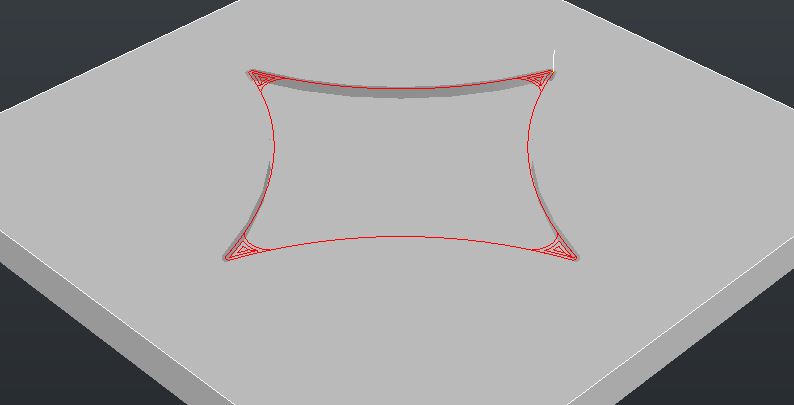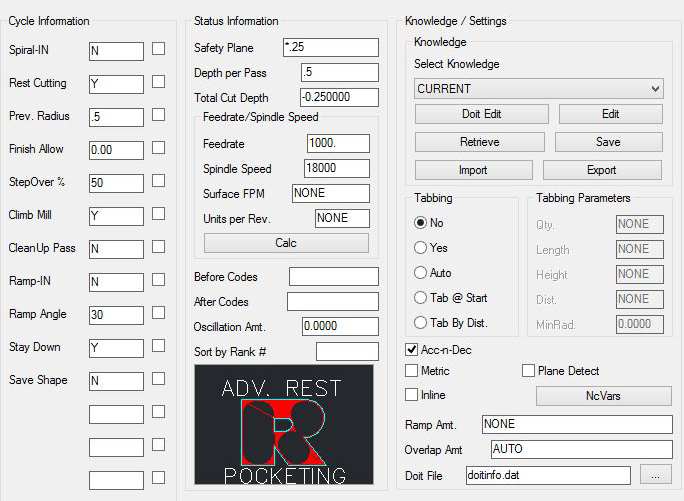|
This version of Advanced Pocketing allows you to use this cutting cycle in order to find the REST of the material left over from a previous pocketing cycle.
An example of this would be if you were to use a cutting tool that has a diameter larger then twice the diameter of the tool you may be using to apply a finish pass around a pocket. The Advanced Rest Pocketing would calculate the clean up needed in order to not leave material by adding additional cut paths.
Note: This cycle is only available on 64-bit Operating Systems. If you are running a 32-bit Operating System, you will be able to use the cutting cycles Spiral Out2In, Spiral In2Out, Linear Pocket ZigZag and Linear Pocket Unidirectional. |

Advanced Rest Pocketing Tool Path

The following parameters effect the toolpath creation:
The value is not applicable to a Advanced Rest Pocketing function.
The value of 'Y' initiates the Advanced Rest Pocketing cycle.
The value entered in this parameter is what the Advanced Rest Pocketing cycles uses to determine the amount of clean out passes it will need to make based on the tool that is selected for use in this cut cycle and what is entered into this parameter.
The value should be the radius of the tool that was used to pocket the overall geometry.
The value entered here will be added to Finish Pass above to provide material left for a clean up pass on the pocket with a separate tool.
This value is the percentage of the tool diameter between each pass of the tool in the pocket. This needs to be a real number such as 25.0 or 50.0.
The value represents if the cutting cycle will be doing Climb (CCW) milling <Y> or if you want the cutting cycle to do Conventional (CW) milling <N>
A CleanUp Pass is described as an additional tool path that travels around geometry allowing you to use Cutter Compensation for the boundary of the geometry.
A Ramp-In set to <Y> will allow you to have the cutting cycle enter the cut with a ramp instead of a plunge. If this parameter is changed from the default of <N>, then the parameter of Ramp Angle will need to be defined in degrees.
If Ramp-IN is set to <Y>, then this parameter would need to be defined. The parameter will need a numeric value defining the degrees of the ramp such as 30 or 45.
The safety plane is the index plane Z location. If a ' * ' is used as the first character, that position is absolute in world Z coordinates, otherwise it is considered to be the distance above the shape.
This controls the depth per pass in Z. It is also the initial Peck Increment.
This parameter controls the total depth of the cut. If a ' * ' is used as the first character, that position is absolute in world Z coordinates. If it does not, then that distance is considered to be the distance below the initial shape.
Initial feedrate to start the drilling operation.
The RPM value to use for the spindle for this tool path.
Values placed here will be output in the cut cycle before the tool enters the material, typically at the height of the Safety Plane once the tool length compensation is set.
Values placed here will be output in the cut cycle after the tool has retracted from the cut, typically at the height of the Safety Plane after the cut is finished.
A numeric value to use for the tool path created to allow the Sequence to place cuts in a specific order when the code is created.
**Changing values in the cycle parameters may yield unexpected results with some settings or on some geometry. Examine the toolpath and NC Code carefully before running your machine tool if you change these default settings.